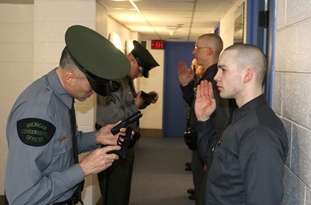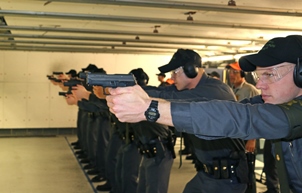Keeping the public safe
Week 10: March 6-12
 Nineteen recruits returned for week 10 of the Michigan Department of Natural Resources conservation officer training academy. Firearms training encompassed much of this week – as it would for the next three weeks – including the recruits’ first experiences on the Michigan State Police (MSP) shooting range. Nineteen recruits returned for week 10 of the Michigan Department of Natural Resources conservation officer training academy. Firearms training encompassed much of this week – as it would for the next three weeks – including the recruits’ first experiences on the Michigan State Police (MSP) shooting range.
Monday morning began with a 4.2-mile formation run, followed by breakfast and inspections. A first happened during inspections this week: Each recruit was issued a primary firearm, a Sig Sauer .40-caliber handgun, and morning inspections now included a gun cleanliness inspection.
Laws covering domestic violence
Following inspections, the recruits marched into the classroom for their first instruction of the week: laws covering domestic violence situations, taught by retired MSP Inspector David Greydanus. This portion of training focused on laws and elements to those laws, such as the differences between domestic violence and nondomestic violence assaults and the penalties associated with these cases. Response procedures would be covered later in the week.
“Conservation officers respond on occasion to domestic violence calls, especially in rural areas where law enforcement personnel are limited,” said Cpl. Todd Thorn, assistant recruit school commander. “It’s important for the recruits to understand all elements of domestic violence situations and how to appropriately respond to them.”
Traffic control
During the hour preceding lunch, Conservation Officer (CO) Troy Van Gelderen, recruit school staff member, taught traffic control methods. The recruits were instructed how to control traffic around an accident or stalled vehicle on a roadway or intersection. Classroom instruction covered vehicle positioning, the use of flares and how to set them up to guide traffic, use of reflective vests, positioning oneself in a safe position and more.
Firearm education begins
Recruits spent the entirety of Monday, Tuesday and Wednesday afternoons in the classroom for firearms education, a mandatory Michigan Commission on Law Enforcement Standards (MCOLES) curriculum, instructed by CO Chuck Towns. Conservation officers receive the same MCOLES training – including firearms – as other Michigan law enforcement officers, including Michigan State Police troopers.
The recruits, consisting of 18 men and one woman, learned concealed pistol license (CPL) laws, safe firearm handling and transporting, firearm components, how a firearm mechanically functions, proper firing methods (through video and instruction – they did not actually fire their guns until Thursday afternoon), proper cleaning techniques and much more.
“Even though many of the recruits have handled firearms prior to attending the academy, we still begin training at the very beginning and cover all basics,” Cpl. Thorn said. “We make certain they have a complete and in-depth understanding of all aspects of the firearm before practicing on the shooting range. We start training assuming that some know how to shoot a firearm, but may not have been taught proper techniques.”
Recruits must qualify with their firearms in order to become conservation officers, meaning they must pass a field test based on their shooting abilities, in addition to the MCOLES licensing exam.
Importance of communication
Tuesday and Wednesday mornings, recruits were back in the classroom to learn response procedures for domestic violence situations. Taught by Lansing Police Department Lt. Cherie Ballor, recruits learned how to respond to and control these potentially volatile situations, how to effectively communicate with the victim, and the importance of follow-up with the victim to provide assistance information.
“Recruits also practiced role-playing exercises during the instruction,” Cpl. Thorn said. “With Lt. Ballor’s guidance, recruits practiced interviewing the victim and the suspect, also played by recruits.” Recruits were guided to ask specific questions to obtain information from the victim, who may be trying to protect the suspect.
During this time, recruits also participated in a domestic violence response scenario, involving an argument between a husband and wife and a corresponding assault.
Connecting the dots
 Unbeknownst to the recruits, their workday was about to get even longer. Shortly after lights out, the recruits were awakened by recruit school staff for a nighttime training scenario, comprised of a traffic stop. Unbeknownst to the recruits, their workday was about to get even longer. Shortly after lights out, the recruits were awakened by recruit school staff for a nighttime training scenario, comprised of a traffic stop.
After being briefed as a group, recruits progressed in pairs through a simulated (and graded!) traffic stop scenario. Among other things, they were graded during this pass or fail exercise on how well they utilized strong tactical approaches during the stop, conducted themselves appropriately, and followed all radio procedures, which they’d learned during radio communications training during week two of the academy.
The previous nighttime training scenario, held during week six, involved a report of a vehicle in a state recreation area after it had closed to the public. Each recruit had made contact with the individual, who’d informed them that his tree stand had been stolen and he’d been searching for it. He’d also given the recruits the name of a possible suspect.
Wednesday night, recruits were expected to put two and two together. During the simulated traffic stop, those recruits who scanned the inside of the vehicle may have noticed something of interest in the back seat – a tree stand. And those who had taken down the name of the potential suspect from the last scenario may have, when the driver of the stopped vehicle gave them his name, noticed that the name matched that of the potential tree stand thief.
“Connecting or not connecting the dots between the two nighttime scenarios certainly paid dividends toward their pass or fail of this particular exercise,” Cpl. Thorn said. “It pays to pay attention at all times. As conservation officers, attention to detail isn’t a nicety; it’s a necessity.”
Assault statistics
Thursday morning, recruits received nature and prevalence of domestic violence training. The instruction delved deeper into how domestic violence situations occur, what typically leads up to domestic violence, and the frequency with which it occurs. Recruits also learned statistics on assaults on law enforcement officers who respond to these situations. Federal statistics show that between 1996 and 2012, nearly 100 officers in the United States were killed while responding to domestic violence-related calls. Hundreds more were injured.
“Domestic violence situations can be some of the most dangerous calls in which to respond,” Cpl. Thorn said.
 Sparking flares Sparking flares
Thursday morning wrapped up with traffic control training outside. Recruits set up and sparked flares and strategically directed traffic around a vehicle staged on a road near the training facility. Recruit school staff drove vehicles on the road to give recruits practice with stopping and directing traffic around the staged vehicle.
On the range
Thursday afternoon, recruits walked to the adjacent MSP shooting range for their first academy-directed shooting practice. First, however, they were given a very long list of range safety procedures. Once understood, the recruits shot their issued firearms for the very first time. Recruit school staff – all conservation officers – observed the recruits and gave them specific instructions for improvement.
That evening, they completed an extensive legal exam, finishing up around 8:30 p.m.
 Friday morning, recruits received more practice and instruction on the shooting range. After exam review that afternoon, they were dismissed for the weekend. Friday morning, recruits received more practice and instruction on the shooting range. After exam review that afternoon, they were dismissed for the weekend.
By the end of next week, they’ll be halfway through the academy, but it won’t be downhill from there. Each week builds on the previous, and every day brings more and greater challenges. This will continue until graduation, and then, as probationary conservation officers, they’ll go through 18 additional weeks of training in the field.
Subscribe to the weekly conservation officer academy blog, which also is posted weekly on the Michigan DNR Facebook page. View past blogs from Recruit School No. 7.
# # #
/Photo details: Accompanying photos are available below for download. Caption information follows.
Morning inspections.jpg: This week, conservation officer training academy staff began inspecting recruits' primary firearms during morning inspections. The firearms are inspected for cleanliness.
Traffic stop scenario.jpg: Recruits participated in a nighttime traffic stop scenario.
Setting up flares.jpg: Recruits practiced setting up flares and strategically directing traffic around a vehicle staged on a nearby road.
Shooting range.jpg: Recruits practiced at the Michigan State Police shooting range for the first time during the academy./
The Michigan Department of Natural Resources is committed to the conservation, protection, management, use and enjoyment of the state’s natural and cultural resources for current and future generations. For more information, go to www.michigan.gov/dnr.
|